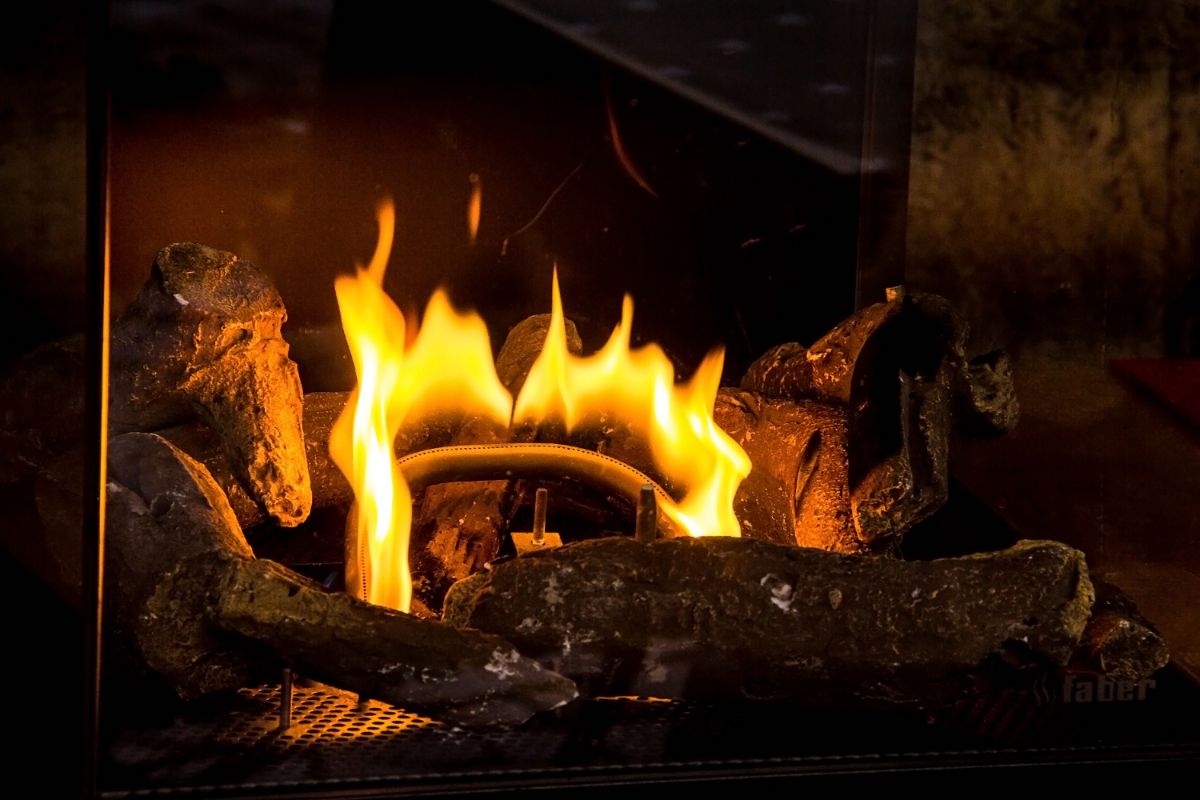The sound of a roaring fire is comforting to many people, but for many homeowners, it’s impossible to install a traditional wood-burning fireplace in their homes. This is where gel-fueled fireplaces come in.
These impressive devices let people install fireplaces in areas without a gas connection, electricity, and even a chimney! You can even find portable options, letting you move the fireplace to a different room. The only thing you need to operate these fireplaces is gel fuel.

Despite their advantages, gel fireplaces may not be the best solution for some. If you’re trying to decide whether these devices are right for you, you’re in the right place!
You’ll find our in-depth review of gel fireplaces below. This answers questions like whether gel fireplaces need venting (see also ‘What Is A Direct Vent Fireplace?‘), if they create the same ambiance as classic fires, and whether they produce enough heat to keep you warm in the cold.
If you’re ready to find out if gel fireplaces are right for you, keep reading!
How Do Gel Fireplaces Work?
Lighting a fire in a gel fuel fireplace requires isopropanol alcohol gel canisters as fuel for the flames.
Gel fuel cans tend to weigh around 13 ounces, which is enough to burn for roughly 2-3 hours.
These steps will help you get a fire going:
- Take the paper off of the gel fuel can.
- Remove the lid from the can.
- Position the canister into the space within the fireplace. Take extreme caution to avoid spilling the flammable substance. Some fireplace models can hold more than one canister to produce more heat and light.
- Use a long-handled lighter or a long match to light the gel. The length of these will help you stay well away from the flames once they light up.
If you want to put the flames out before the gel fuel runs out by itself, follow these steps.
- With caution, let the lid fall back on the can to extinguish the flames
- Leave the cans to cool fully before taking them out of the fireplace or relighting the fire. This process should take around an hour.
Relighting a fire after putting gel fuel flames out isn’t always ideal, as the flames will be less powerful than they were when they were first lit.
You should also never add new fuel to older fuel containers.
Gel fireplaces and fuel canisters do have an advantage, as they don’t need as much maintenance as traditional fireplaces.
All you have to do is remove the used gel canisters, then remove dust from the hearth with a soft cloth every so often.
Types of Gel Fireplaces
A good thing about gel fuel fireplaces is that they come in several versatile options. You can find ones that can be used indoors and outdoors, as well as portable ones that can travel between locations.
Gel fuel fireplaces also come in many different designs, including wall-mounted options, outdoor fire pits, and mid-century modern styles.
Homes that are already fitted with gas or wood fireplaces can change this space into a gel fuel option by using a log insert.
This will keep the look of your original classic fireplace with a cleaner gel fuel source.
Gel Fireplaces and Venting
One of the best things about gel fuel fireplaces is that they can be used in many different places.
They don’t need to be connected to gas, electricity, or a chimney, provided that they are stationed in a well-ventilated place.
This is great for people who did not have the space for a traditional fireplace, including renters who cannot add new appliances to their residences.
Gel fireplaces are also easy to install. The only requirement is an even resting surface to avoid hazardous falls.
Gel fuel is a lot more environmentally friendly compared to other fuel sources, as it burns without releasing fumes, soot, or any other chemicals.
Despite this, some worry about gel fuel as it produces carbon monoxide when it is burnt.
Any substance that burns will produce a certain amount of carbon monoxide. However, gel fuel only releases a tiny amount of this gas.
At 16 parts per million, the carbon monoxide gel fuel releases is much less than 250 parts per million, the amount that is safe for human exposure.
However, as gel fuel does release carbon monoxide, it’s extremely important to install the fireplace in a well-ventilated area.
If there isn’t sufficient air circulation, the carbon monoxide can begin to build up over time. This can lead to headaches, dizziness, and nausea. In more serious cases, residents may become weaker and lose consciousness.
If you do decide to install a gel fireplace, you’ll need to make sure your room has enough air circulating through it to avoid harmful gases from accumulating.
This will also make sure that there is enough oxygen in the room to maintain flames when in use.
Will Gel Fuel Fireplaces Recreate A Classic Fireplace Feel?
Gel fireplaces produce flames that are orange, yellow, and red, like the flames within a traditional wood fireplace.
All gel fuel cans have the same isopropyl alcohol base, but some canisters have additives made from other substances to recreate crackling sounds that come from burning wood.
These canisters usually cost extra, but with these, gel fuel fireplaces can recreate the comforting sounds of a normal wood-burning fireplace.
These won’t mimic the smell of a wood fire, but this is for the best. Campfire smells involve breathing in fumes and chemicals that can pose health risks.
Gel fuel burns cleanly, which is a lot easier on the environment and your lungs.
Do Gel Fireplaces Burn For A Long Time?

Unfortunately, gel fireplaces will not keep burning for a long time. If you care about keeping a fire going for a few hours, you may want to consider investing in a classic fireplace.
Once gel canisters burn out, they need to be replaced, but you’ll need to wait for them to cool fully before you can replace them.
This can take up to an hour depending on how many canisters were used, so you’ll have to wait for a long period between starting different fires.
Gel Fireplaces and Their Heat Output
Gel fireplaces do produce some heat, but it’s best not to rely on them for direct heat, as they won’t heat up as much as other types of fireplaces.
People looking for searing fires to heat them in wintry conditions may want to look elsewhere.
However, if you live in a climate with moderate winter temperatures, gel fireplaces with lower heat outputs may be a good thing.
You’ll be able to enjoy a real fire experience without the added heat.
Despite this, if you live in a very warm location, electric fireplaces might be a better option compared to gel ones.
Electric models will mimic the appearance of classic flames without delivering heat to warm up a room.
One gel fuel canister produces around 3,000 British Thermal Units (Btus) every two to three hours.
This means that larger fireplaces that can hold three cans won’t be able to deliver over 4,500 Btus every hour.
To put this into perspective, wood-burning fireplaces can deliver 20,000 – 80,000 Btu every hour.
Gas fireplaces can produce 8,000 Btu every hour on the smaller end, and 60,000 Btu per hour on the larger end.
Electric fireplaces (see also our review of the Dimplex Electric Fireplace) aren’t designed to emit heat, so they only generate between 4,600 and 9,000 Btu every hour.
Gel fuel fireplaces only generate as much heat as electric models.
While you can simply turn up the heat on electric and gas fireplaces, and add more wood to a wood-burning model, you cannot adjust the temperature on gel fuel fireplaces. Gel fuel cans will be in one of two states, not burning or burning.
Do Gel Fuel Fireplaces Cost More?
The final thing you should consider when thinking about purchasing a gel fuel fireplace is the cost.
Gel fuel fireplaces can cost anywhere from $400 to $900, but as these products are new designs, you’ll have to look around a lot to find the right model.
The cost to install a wood fireplace ranges from $2,000 to $5,600. Gas fireplace installation costs between $2,300 and $4,000, while plug-in electric models cost less, $100 to $700.
This may make gel fuel fireplaces seem like an affordable option, but you’ll need to factor in the cost of fuel canisters.
You might start out saving money with a gel fuel fireplace, but at around $4 each, the cost of these can build up a lot.
Electric fireplaces usually cost the least to run, with gas and wood models following afterward.
If you plan on using your fireplace regularly, it might be worth going for one of these options rather than a gel-fuel one.
The Bottom Line
Gel fuel fireplaces are eco-friendly and better for your lungs, but they come with their disadvantages too.
These models cost more to run and need to be placed in a well-ventilated area to work safely.
If you rely on a fireplace for heat, you’re better off opting for a gas or a wood fireplace, as they don’t emit much heat.
However, if you only want to use your fireplace occasionally, and would rather opt for clean-burning fuels, gel fuel fireplaces may work well in your home.
- Discover the Ease and Elegance of Zero-Clearance Fireplaces - July 24, 2023
- How to Build a Frame for an Electric Fireplace Insert: A Step-by-Step Guide - July 16, 2023
- Bedroom Fireplace Ideas That Will Make You Want to Snuggle Up - July 16, 2023








